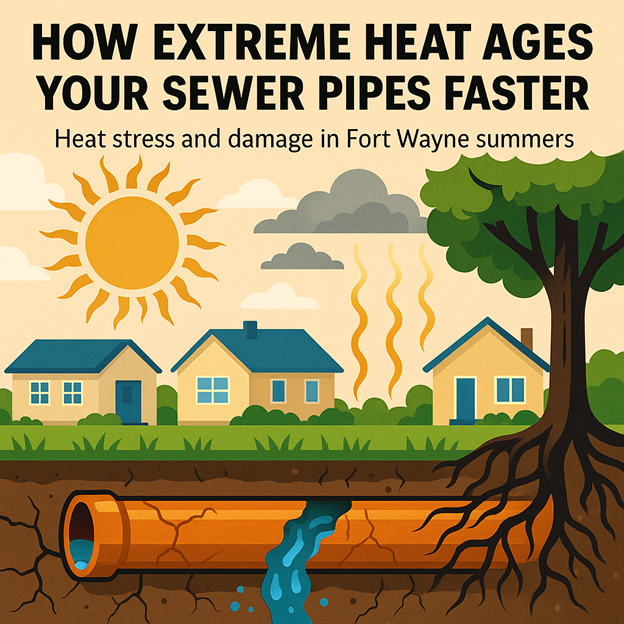When Fort Wayne faces weeks of scorching temperatures, your home isn’t the only thing under stress — your sewer system is, too. With the Midwest experiencing increasingly intense heat waves, homeowners in Indiana must now contend with a new kind of infrastructure challenge: thermal stress. Underground sewer pipes, often hidden and forgotten, bear the brunt of prolonged heat exposure. The combination of shifting soils, expanding materials, root aggression, and pressure imbalances can cause a sewer line to fail far sooner than expected. Understanding how heat interacts with your plumbing is no longer a luxury — it’s essential maintenance knowledge.
1. Heat-Driven Soil Shifts Can Crack Sewer Lines
- Indiana’s clay-rich and loamy soils naturally retain moisture, but during extreme heat, they dry out and contract dramatically
- This shrinkage creates empty air pockets underground, leading to sudden soil shifts and sinkholes
- These movements strain buried pipes, especially older ones made from brittle materials like clay, concrete, or cast iron
- Minor shifts can cause microfractures, while more severe movement may lead to full pipe collapses or disconnections at joints
- Homeowners with historic or pre-1970s homes are most at risk — especially if pipe inspections haven’t been conducted in over a decade
2. Plastic Pipes Aren’t Immune to Heat
- Modern sewer systems often use plastic pipes like PVC (polyvinyl chloride) or ABS (acrylonitrile butadiene styrene)
- Though more flexible than clay, these plastics soften with sustained exposure to heat exceeding 140°F — a temperature soil can reach during heatwaves
- Expansion and contraction cycles cause misalignment at pipe joints, weakening watertight seals
- Over time, this can result in hairline leaks or sagging pipes (called “bellies”) that trap waste and increase the risk of blockage
- In worst-case scenarios, full structural failure occurs without warning
3. Tree Roots Thrive in Summer Heat
- Trees are intelligent survivalists — in hot weather, their roots spread aggressively toward water sources
- Sewer lines, especially those with small leaks or porous joints, become magnets for thirsty roots
- Once roots penetrate a pipe, they expand rapidly inside, forming dense clogs that obstruct wastewater flow
- Fort Wayne’s older neighborhoods, often lined with mature shade trees, are particularly susceptible to this form of root intrusion
- Root-related sewer backups tend to spike during droughts, when natural ground moisture is scarce
4. Extreme Weather Increases Water Usage
- High temperatures mean higher water consumption: more showers, running sprinklers, filling pools, and frequent laundry
- This increased volume strains sewer systems that are already compromised by heat-related shifts or intrusions
- Older pipes may not have the capacity or strength to handle sustained high-flow activity
- The result? Backups in basements, slow draining sinks and tubs, or bubbling toilets — all signs that pressure inside your line is reaching a breaking point
- Left unaddressed, this stress can lead to ruptures or contamination of nearby soil
5. Sewer Gas Odors May Worsen in Hot Weather
- Sewer gas (primarily methane and hydrogen sulfide) becomes more volatile and detectable in extreme heat
- High temperatures accelerate the decomposition of organic matter in your lines, producing stronger and more frequent odors
- If your traps dry out (common in unused drains), gases may escape directly into your home
- Faulty venting or cracked pipes beneath the house can make this worse, posing health hazards to children and pets
- A musty smell in your basement, crawlspace, or bathroom during summer isn’t just unpleasant — it’s a red flag
6. Heat Exposes Existing Pipe Weaknesses
- Every sewer line has a lifespan, and extreme weather events accelerate that timeline
- Pipes weakened by rust, chemical corrosion, ground movement, or previous improper repairs can buckle under thermal stress
- Sudden pipe collapses are more likely during heatwaves because soil doesn’t cushion pressure as well when it’s dry and compacted
- Warning signs often go unnoticed — small wet spots in your lawn, sudden rodent activity, gurgling sounds from drains, or random patches of lush green grass
- A camera inspection is the only sure way to identify internal damage before a full failure occurs
Bonus Tip: Install a Cleanout Cap with Pressure Release
- Cleanouts are critical access points in your plumbing system, typically located near the home or sidewalk
- Installing a cleanout cap with a built-in pressure relief valve allows excess air or gas to escape, preventing blowouts
- These caps also protect against backflow during floods, water surges, or sudden clogs
- They are especially useful in homes with children or elderly residents, reducing the chance of sudden indoor overflows
Fort Wayne Fact:
Many homes in Fort Wayne’s historic neighborhoods — including Southwood Park, Lakeside, and North Anthony — still rely on original clay sewer systems installed in the mid-20th century. These aging lines are vulnerable to summer’s triple-threat: soil shifts, heat warping, and root infiltration.
Don’t Let the Heat Drain Your Wallet
Your sewer system might be buried, but the warning signs of trouble often surface where you least expect them — in the form of a basement smell, a soggy lawn, or slow-draining sinks. The combination of extreme heat and aging infrastructure makes preventive maintenance more important than ever. Don’t wait for a costly emergency. If you suspect even a minor issue, AAA Sewer Service offers state-of-the-art camera inspections, hydro jetting, and 24/7 emergency repairs.
📞 Call AAA Sewer Service at (260) 456-6930
🌐 Visit our website: www.aaasewerservice.com

